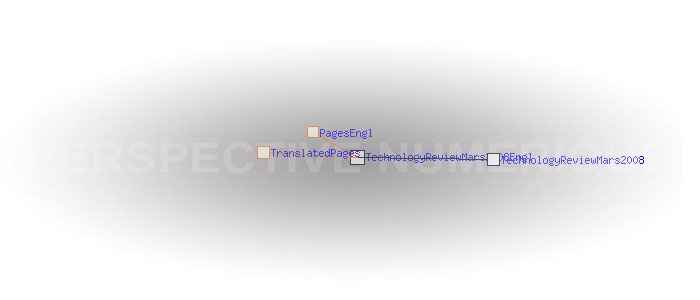

|
"L'acte de penser et l'objet de la pensée se confondent" Parménide Full Screen | Play Le contenu de ce wiki est Copyleft
|
Olivier Auber: The Digital Perspectiveby Elen S. Riot, Technology Review, 03 2008 TranslatedPages | PagesEngl Olivier Auber: The Digital Perspective Elen S. Riot Unclassifiable artist, engineer, inventor and muséographe inspired, Olivier Auber is the author of an amazingly varied focuses around a central theme: that of collective intelligence. Developer adopting a posture critical of devices reticular 1qui today hybrident and mix on the Web, Olivier Auber advocates alternative and is "a rebel with a cause." In contrast to existing devices based mostly around a central server, he built a patient-centered tools enabling everyone to share independently and reciprocal. Defending a society, it is not only a supporter of free software and wikis, it is primarily a developer of digital worlds. Gateways A graduate of Arts and Trades, Olivier Auber begins very early to launch its own projects it develops outside the institutions in a micro-community of researchers and creators. He is interested in all sorts of new representations and cultural bases AH lab to create bridges and creating synergies between its different projects. It is "to imagine the identities of the future taking into account the intersection of physical and digital territories and to invent new collective practices through networking." Its partners may be local, like the design / creation of the Museum des Nibelungen in Worms or project Rimbaud in Charleville-Mezieres, or innovative SMEs as the company Navid which he is a founding member. Universe in gestation All of his work redraw the boundaries between real and virtual, and between individual and collective, so that it lies within the confines of art and Social Council, in an area that the author considers to anthropology. Most projects are developed and presented on the site of cultural laboratory (http://km2.net) referring to many wikis, which are archival materials or for development projects. Most of them implement visualization tools developed under the research group "anoptique", which he founded in 2004 with the artist Yann Le Guennec. Both specialist "meta-design", trying to highlight the topology of the infrastructure through which the group (or host) to exist. In a way, they work the field of mental representations. Autopoiesis At the root of all its projects is the Poïétique generator, a device-centric enabling a large number of people to interact individually synchronously on a single image. It is a game where the graphics that connects a small mosaic colors juxtaposed with that of other users. In echoing the designs of other players (visible by all), everyone contributes to the achievement of a design collective constantly evolving. Inspired by the game of life (algorithm Conway), the generator Poïétique is published under license artlibre?. The first experiments were conducted in 1987 on Minitel. He has worked since 1995 on Mbone2? Internet and since 1997, it is accessible to all on the web. The generator Poïétique has attracted many experiences derived proposed by Olivier Auber or other creators, as Yann Le Guennec who designed the poïétique3 aggregator. L '@ rbre in particular is a program that allows everyone to build and display its pedigree in three dimensions and to connect with those of other peer-to-peer without going through any central server. This project, in collaboration with the School of Computer Engineering and the Ecole Nationale Superieure des Telecommunications de Brest, was supported by the Canadian government. The invisible monument is an urban planning project which is coming into a parallelepiped 24 m wide and 30 m high. At the option of time, the sky and superimpose the image of the sky in 3D through mirrors mobile robot. In the eyes of Olivier Auber, which is interesting in this project so much to achieve optical invisibility to show that the process that makes possible "the intelligence awakened always steers the mirrors to try to s Adapt better to changes in the sky. " The Digital Perspective Maps, genealogical trees, Poïétique generator, all these creations are part of the vision of a new "Digital Perspective" dear Olivier Auber who defined in reference to the Quattrocento revolution and the mode of representation introduced by Florentine painters. The changing face is not only to believe in the immediacy and simultaneity of networks, but in space and time to own code. You can see all of this work as the equivalent of the experience of Tavoletta Brunelleschi front of the cathedral of Santa Maria della Fiore.4 At the border of poetry and politics, it is now to build all "legitimate forms of code-sharing, so that everyone can accept successor to another to contemplate the sublime performance of the network. " (Hyper) news: http://perspective-numerique.net (Hypertext on the concept of Digital Perspective) http://www.albertinemeunier.net/BigPicture/ (Overall viewing experience of Facebook, in collaboration with Albertine Meunier and Yann Le Guennec.) NOTE In 1415, FilippoBrunelleschi showed the central principle of perspective in carrying out an experiment on the Piazza San Giovanni in Florence. He painted the buildings in front of him on a small wooden plaque (the "tavoletta"), in conformity with the prospect, then drill a small hole corresponding to its point of view. He then put a mirror behind the plate and looked through the hole. It could then observe the overlay of painted buildings reflected in the mirror with real buildings. This episode appears as the founding moment where the demonstration is a prospect "unnatural" can structure the visual representations whether architectural or pictorial.
Il n'y a pas de commentaire sur cette page.
[Afficher commentaires/formulaire]
|